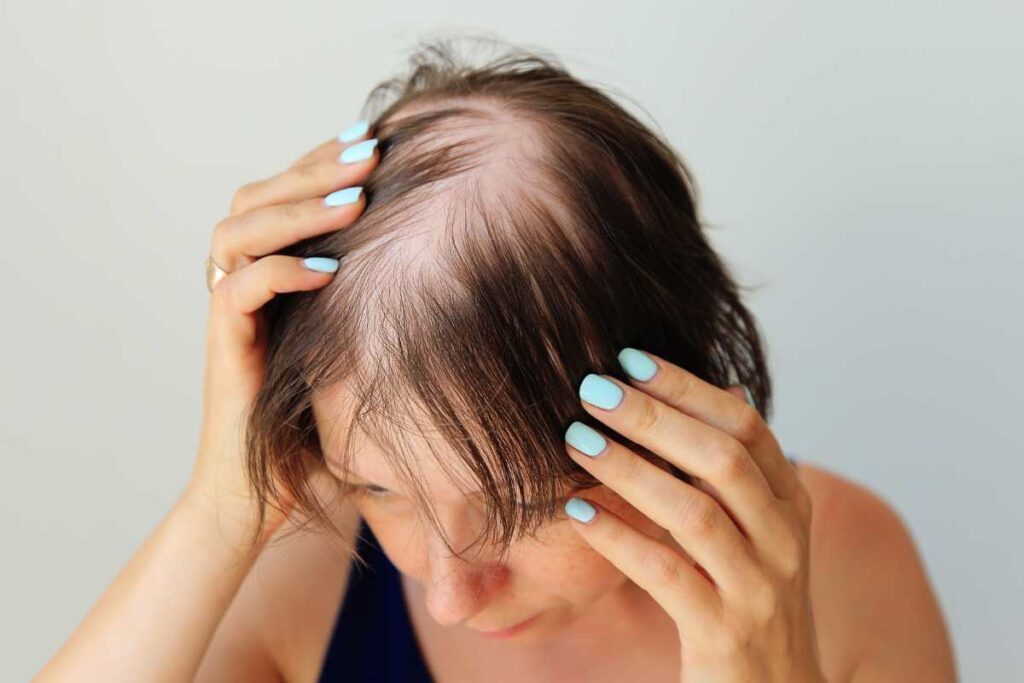This article includes affiliate links. We may earn a small commission if you access Happy Head telehealth services and solutions. The companies we work with are carefully vetted. However, we do not guarantee their products and services.
If you’ve noticed hair changes during the menopause journey—whether it’s changes in texture or density—you’re not alone! While men may go bald, this is often not the case for women+. Still, if it happens, hair loss can impact a woman’s self-esteem. Learn the ways your hair can change during the menopause journey and the prescription treatments and healthy lifestyle tips that can help your body promote hair growth.
How common is female hair loss?
Before the age of 60, 20-60% of women experience hair loss. While hair loss (alopecia) is often associated with aging men, in women+, it’s known as female-pattern hair loss (FPHL).
In a study of postmenopausal women (ages ~55+), about half (52.2%) exhibited female pattern hair loss to varying degrees.
It can occur during any stage of the menopause journey.
Whereas men often experience a receding hairline and baldness on the crown, women may experience a gradual thinning at the part line followed by increasing hair loss from the top of the head. Luckily, it rarely progresses to total baldness as it might in men!
These are wide ranges (20-60% impact) in how common hair loss is in women+, partly because comprehensive studies around hair loss and menopausal women are lacking. Given their impact on the menopause experience, causes and solutions for hair changes will hopefully receive more attention in future research.
Hair changes also vary by ethnicity. For example, African American hair breaks more easily and earlier than Caucasian and Asian women. See this pausitive health article to learn more about these differences!
But just because hair loss is common in women+ doesn’t mean hair changes are always easy. Depending on your gender/gender identity, a head of hair can be associated with femininity. As a result, this shift may cause psychological difficulties—including your body image and self-esteem. (Some women+ may even fear others will assume they have a serious medical condition, like cancer or HIV, as the cause and may be concerned about risks to employment, career advancement, etc.)
Therefore, while it’s not always indicative of an underlying medical problem, it’s worth exploring the potential causes of hair loss and ways you might improve the situation!
What types of hair changes happen during menopause?
During menopause, you can experience several types of hair changes. These include:
1. Reduced hair growth and density on the scalp.
It’s normal to lose some hair each day—in fact, losing 70-100 hairs is standard! But when hair loss goes over that range for more than a few weeks, it is then considered excessive. As mentioned in the description of female-pattern hair loss, women tend to lose hair from the central part outwards.
2. Hair growth on the face
As estrogen levels decline, it’s common for women to experience hair growth on their chin, cheeks, and upper lip.
3. Body hair loss
Body hair loss is significantly correlated with older age. Especially if you’re a postmenopausal woman+, you may notice less leg hair—a welcome change for some women+ who choose to shave their legs regularly.
4. Dry hair and scalp
During menopause, you may have noticed drier skin. It turns out your scalp and hair can get drier, too!
When estrogen levels lower, less sebum (an oily substance produced by glands in the skin) is produced. On your scalp, sebum acts as a lubricant that infuses into hair. Without it, hair can be duller and more prone to breakage.
Some women even notice their hair feels wiry or coarse or more than it has been. Additionally, a dry scalp can be itchy.
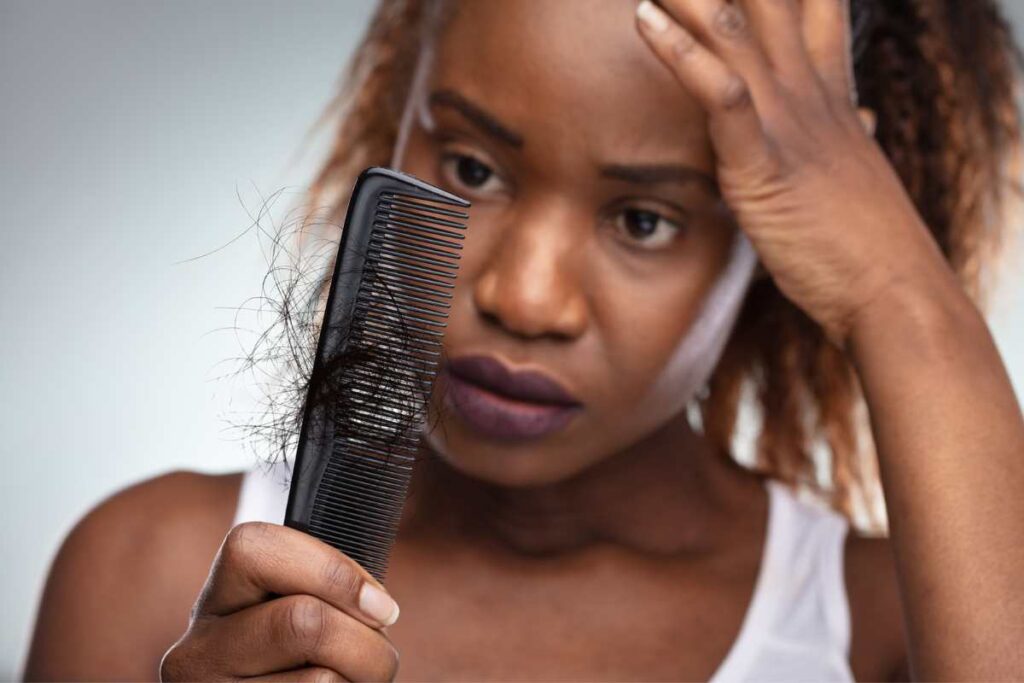
Key terms to know when talking about hair
Understanding more about the anatomy of hair and how it grows can be helpful to coping with changes and seeking care. Below are descriptions to increase your knowledge.
- Hair shaft: The part of hair that can be seen.
- Hair follicle: The part of hair below the skin that produces the hair shaft.
- Hair cycle: One cause of hair loss can be changes to the hair cycle. Understanding how this cycle works can help you understand what’s happening in your body. It consists of 3 phases that all hairs cycle through continuously:
- Anagen phase: This is the growth phase of hair. 85% of hairs are in this phase, and a hair follicle usually grows for almost four years.
- Catagen phase: This is the transitional phase between hair growth and rest. A few hairs may be in catagen at any given time, and it lasts around 2-4 weeks.
- Telogen phase: This is the rest period. 15% of hairs are in this phase which lasts around 4 months. When the rest period is over, a new anagen hair begins to grow under the resting telogen hair and pushes it out. See the section below on telogen effluvium to learn more about hair loss during this phase.
- The Ludwig Scale: a measure of female hair loss density.
What causes hair loss and dryness during menopause?
1. Stress and lifestyle
Have you ever heard the phrase “This will make my hair fall out!” during a stressful experience? Turns out, it’s more than just a saying. Hair loss can be a symptom of stress. When hair cells are exposed to increased levels of corticosterone, a stress hormone, the follicles may stay in an extended resting phase.
The good news is that when stress is the cause of hair loss, regrowth is possible. The rate at which it comes back will vary. In the meantime, focus on taking great care of yourself through sleep, nutrition, exercise, and other stress-reducing techniques.
2. Hormonal changes
During the menopause journey, there is a relative increase of androgens. While menopause is most often associated with a rapid decline in estrogen and progesterone, androgens (male sex hormones that women have in small amounts) such as testosterone also decline with aging, only gradually. Therefore, while androgen levels might not be getting higher, their ratio to estrogen increases, i.e., there is more testosterone relative to the amount of estrogen.
This can lead to clinical hyperandrogenism (an excess of androgens). In this case, androgenetic alopecia, or hair loss due to androgens, can occur. It’s worth noting, however, that hair loss doesn’t always indicate hyperandrogenism. In fact, the vast majority of patients with female-pattern hair loss have normal testosterone levels.
3. PCOS
Around 8-13% of women have PCOS, or polycystic ovarian syndrome, though many go undiagnosed. PCOS is defined as a condition in which the ovaries produce an abnormal amount of androgens. It gets its name from the small cysts (fluid-filled sacs) that some women with this condition develop in their ovaries. However, not all women with this disorder have ovarian cysts, and women without PCOS may develop cysts as well.
There’s a wide range of symptoms and experiences in PCOS, including:
- Irregular menstrual cycles
- Ovulation issues and difficulty getting pregnant
- Polycystic ovaries
- Hormonal imbalances
- Insulin resistance (“when cells in your muscles, fat, and liver don’t respond well to insulin and can’t easily take up glucose from your blood”)
- Weight gain, especially in the abdominal area
- Skin issues like acne
- Male-pattern hair growth (for example, on the chin, cheeks, and upper lip)
- Mood swings, anxiety, and depression
Even if you were never diagnosed with PCOS, consider whether you had some of these related symptoms during your menstrual years.
Though most commonly discussed during the reproductive years because of its impact on fertility, PCOS may also impact menopause symptoms such as hair loss.
4. Telogen effluvium
Remember, the telogen phase of the hair cycle? In contrast to the anagen, or growth phase, telogen hairs are in a state of rest.
On a normal, healthy scalp, roughly 85% of hairs are in the anagen phase, and 15% are in telogen.
When telogen hairs shed in excess after scenarios such as metabolic stress, illness, or changes in hormones or medication, it’s referred to as telogen effluvium.
If you’re wondering whether you have this versus other causes, speak to your doctor, who can test whether telogen effluvium is behind your hair loss.
5. Alopecia areata
Alopecia areata is an autoimmune disease in which the immune system attacks hair follicles, resulting in hair loss. In the United States, it affects over six million people. While there is no single known cause, stress may trigger the condition.
Additional causes include:
- family history
- cancer treatment with certain medications smoking
- other autoimmune conditions like vitiligo, thyroid disease, and psoriasis
- issues like asthma and atopic dermatitis
- vitamin D and iron deficiencies
Alopecia areata is more common in African Americans and less common in the Asian community compared to the white population.
One notable distinction between alopecia and hormone-related hair loss is that in cases of alopecia areata, hair may be lost in round patches around the scalp rather than around a part in the hair specifically. The symptoms are not always linear—hair may grow back and fall out at varying rates over time.
6. Nutritional deficiencies
Without proper nutrition, our hair structure and growth can be negatively affected during menopause. Think of nutrients as the fuel your body needs to run.
For example, telogen effluvium has been linked to rapid weight loss and insufficient protein in the diet. Cases of alopecia have been linked to niacin (vitamin B3) deficiency.
Other vitamins and nutrients that play a role in hair health include folate, biotin, vitamin A, zinc, magnesium, and calcium.
Later in this article, we break down the vitamins you need to support hair growth, including proteins, fats, vitamin D, B vitamins, vitamin A, and minerals.
7. High mercury levels
While mercury is a naturally occurring element, it’s also released into the environment through human activities such as manufacturing. Linked to conditions from tremors to birth defects, high mercury levels are also being explored concerning both early-onset menopause and alopecia. Talk to your doctor if you’re worried about mercury exposure.

7 ways to prevent and reduce hair changes
As you navigate hair loss, it’s important to manage expectations. As dermatologists in one study note, treating female-pattern hair loss can take time. Successful treatment doesn’t always mean getting everything back to the way it was before—instead, like many parts of the menopause journey, it means embracing your new normal.
Choose the section you’d like to learn more about to go directly to that content.
- Medication options – oral and topical
- Nutrition (vitamins and minerals)
- Healthy lifestyle
- Avoiding physical stress to hair
- Nourishing hair treatments
- Diabetes management
1. Medication options
When it comes to treatment with medication, there are several options, including both topical and oral formulations. They include both over-the-counter and prescription medicines.
pausitive health has partnered with Happy Head to offer virtual consultations with a board-certified dermatologist with expertise in hair restoration to develop a treatment plan customized to your particular situation plus delivery of certain FDA-approved medications. Learn details about the following medication options here from Dr. Ben Behnam, MD FAAD, Co-founder of Happy Head:
- Dutasteride
- Minoxidil
- Spironolactone
- SuperCapsule™ (minoxidil + spironolactone + essential vitamin D3)
- Finasteride

Grow Your Hair Back in 3 to 6 Months!
Connect with a Happy Head board-certified dermatologist with expertise in hair restoration to develop a treatment plan for hair thinning/loss.
You will also receive a 65% discount on your first order of medication if needed to address your hair issues. Enter code “pausitive” at checkout to receive the discount.
This is an affiliate link. We may earn a small commission if you access Happy Head telehealth services and solutions. The companies we work with are carefully vetted. However, we do not guarantee their products and services.
Ketoconazole
This is a medication used to treat fungal infections. It is found in different formulations, including shampoos to help treat dandruff and topical serum. It also has anti-androgenic effects; some studies suggest it may help with hair regrowth and thickness.
MHT
While menopausal hormone therapy (HT) is not usually prescribed for hair changes alone, if your hair loss is linked to low estrogen and higher ratios of androgens, then it might help with hair loss, but its use would be considered off-label. See our information on MHT and speak with your healthcare practitioner to evaluate whether this could be a good option for you. For transgender women, a gender-affirming hormonal regimen may reduce androgen-related hair loss, as well as facial and body hair.
Platelet-rich plasma (PRP) injections
Performed by a dermatologist, this treatment involves using your own blood cells to speed up healing. It’s been used in sports medicine, wound healing, and even for hair loss.
The PRP consists of plasma (the liquid part of blood) and platelets (blood cells that are vital for healing). Simply put, PRP is blood with more platelets than usual!
It’s thought that the increased concentration of growth factors in the solution may accelerate the hair growth process.
While PRP is considered a safe and effective treatment for female pattern hair loss, more studies are needed to understand the optimal dosing and number of treatment sessions.
Severe alopecia areata medications
If your hair loss is severe and you’re diagnosed with severe alopecia areata, your doctor may prescribe one of the FDA-approved medications for this condition. Ritlecitnib, which is sold as Litfulo™ is a once-a-day pill for severe alopecia areata. The trial was performed with people who lost at least half of their scalp due to alopecia areata. Talk to your doctor, as there is a risk of severe side effects.
Baricitinib tablets, which are sold as Olumiant®, are another treatment option for severe alopecia areata. The trial found up to 22% of people who took it had 80% more scalp coverage in 36 weeks. There are also serious side effects of this medication.

3. Nutritional support
A nutrient-rich diet is always a good place to start, whether or not you’re experiencing hair loss. While there is conflicting evidence about which nutrients affect hair loss—and to what degree—it’s worth amping up healthy foods in your diet.
Focus on:
- proteins
- fats
- vitamin D
- B vitamins
- vitamin A
- minerals
Let’s break down each way you can support the nutrition of your hair and body.
Proteins
Insufficient protein can result in malnutrition—and hair loss.
Sources to enjoy:
- Dairy (cottage cheese and Greek yogurt)
- Fish
- Meat
- Chicken and turkey
- Tofu and tempeh
- Legumes
- Seeds
- Eggs
- Nuts
What about collagen protein?
Collagen protein makes up the building blocks for skin, hair, and nails. Levels decline as we age.
Many women’s health companies and health food stores now tout fish collagen supplements as a solution for hair loss. While the evidence is limited as to what degree oral collagen supplements can help with hair structure and growth, you may want to discuss with your healthcare practitioner and/or registered dietitian if it is worth considering, especially since eating certain foods like these may help support your body’s production of collagen:
- oranges
- bell peppers
- Brussel sprouts
- strawberries
Fats
When it comes to skin and hair health, dietary fats are key. But be careful not to consume saturated or trans fats such as those found in fried and processed foods.
Fat sources to enjoy include:
- Foods high in omega-3 acids, such as fish and walnuts
- Avocados
- Olive oil
Vitamin D3
When was the last time you had your vitamin D levels checked? It’s a common deficiency, especially in women.
While its role in hair loss is being researched, Vitamin D is important for hair follicle growth.
Getting enough sunlight is one of the best ways to keep our Vitamin D levels high. Just don’t forget to practice some sun protection with sunscreen and a hat!
While scarce in food, you can find vitamin D3 in a few and may even see foods fortified with vitamin D.
Sources to enjoy include:
- Fatty fish (salmon, tuna, sardines)
- Beef liver
- Eggs
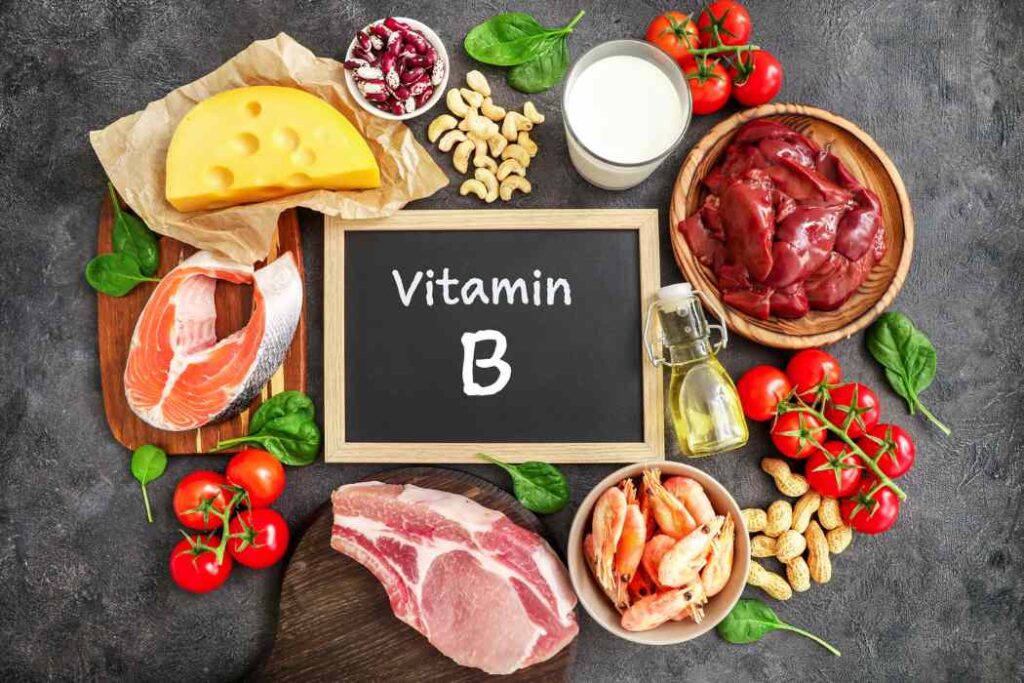
B Vitamins
1. B12
Low B12 can be linked to anemia, a condition that occurs when a body doesn’t produce enough healthy blood cells. One symptom of the anemia is hair loss. Dietary B12 generally comes from animal products, so if you’re vegan, consider taking a B12 supplement.
Sources to enjoy include:
- Meat
- Fish
- Eggs
- Milk and dairy products
2. Niacin (B3)
B3 is referred to as niacin. Niacin is found in meats and plant-based foods. Sources of niacin include:
- Poultry
- Beef
- Fish
- Nuts
- Legumes
- Grains
- Brown rice
- Banana
You can view a full list of niacin-rich foods, and the amounts in each, from the National Institutes of Health.
A Vitamins
Vitamin A helps hair stay moisturized and protected. But be careful not to consume too much, for example, by eating too many animal products, as its excess can actually cause hair loss, possibly due to its impact on the regulation of the immune system.
Sources to enjoy include:
- Liver
- Eggs, especially the yolks
- Dairy Products
- Orange and yellow vegetables including carrots, sweet potatoes, butternut squash, and pumpkin.

Minerals
Eating mineral-rich foods high in zinc, iron, magnesium, and calcium can help with hair loss and other menopause symptoms like sleep and osteoporosis.
1. Zinc
Zinc is important for immune system functioning and wound healing. Its deficiency has been linked to hair loss and brittleness.
Sources to enjoy include:
- Meat
- Shellfish (oysters, crab, lobster)
- Legumes
- Nuts and seeds
- Dairy
- Whole grains
- Spinach
- Mushrooms
2. Iron
Iron deficiency may be associated with hair loss. And iron deficiency can cause anemia. If blood tests show low iron levels, eat plenty of foods such as citrus fruits with vitamin C, which supports iron absorption.
Sources to enjoy include:
- Beef
- Pork
- Liver
- Poultry
- Fish
- Tofu
- White beans
3. Magnesium
Often noted for its roles in healthy sleep cycles, magnesium also supports cell growth and alleviates inflammation.
Sources to enjoy include:
- Cacao
- Legumes
- Whole grains
- Nuts
- Calcium
4. Calcium
Beginning around age 49, women experience a significant decrease in calcium concentrations in their hair.
Sources to enjoy include:
- Dairy products with lactose (cheese, milk, yogurt)
- Green leafy vegetables
- Soy
- Walnuts and hazelnuts
- Fish
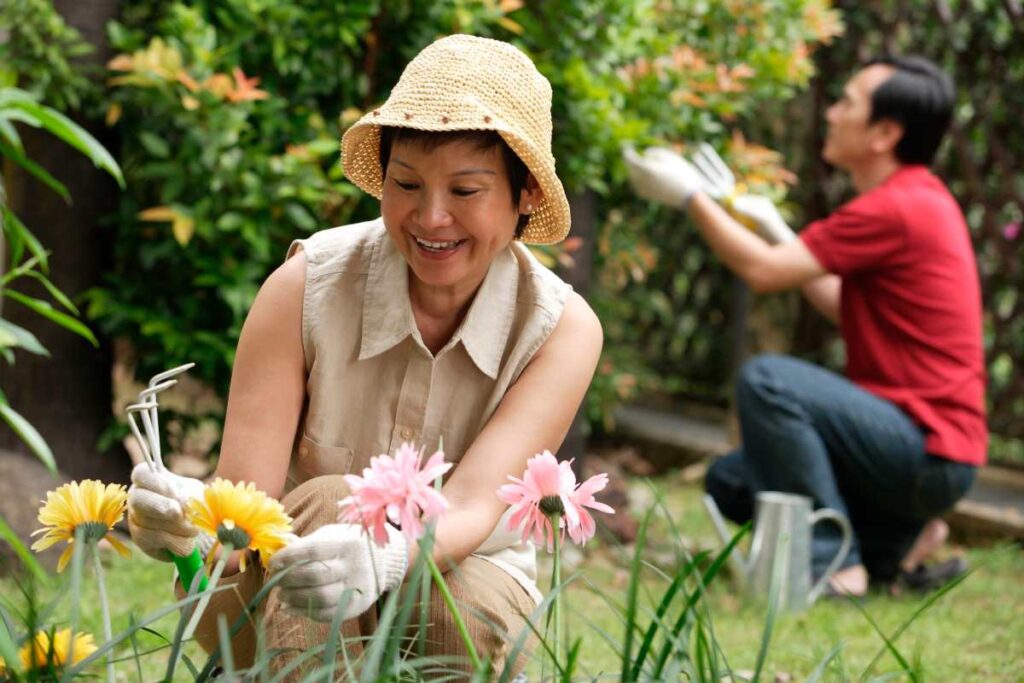
4. Focus on a healthy lifestyle
A healthy lifestyle can also help reduce menopausal symptoms and their severity in many women. Explore these topics in depth with insight from our experts at pausitive.
- Eat a healthy diet (avoid excessive carbs)
- Engage in physical activity.
- Get enough high-quality sleep.
- Achieve and maintain a healthy weight.
- Weight loss
One of the best ways to keep your androgen level in check is sufficient weight loss to reach a healthy weight. In fact, in one study, “after adjusting for weight and family history only a body mass index (BMI) greater than or equal to 25kg/m2 was associated with hair loss in postmenopausal women.” But it’s important to do so in a healthy way, as too rapid weight loss can cause hair loss.
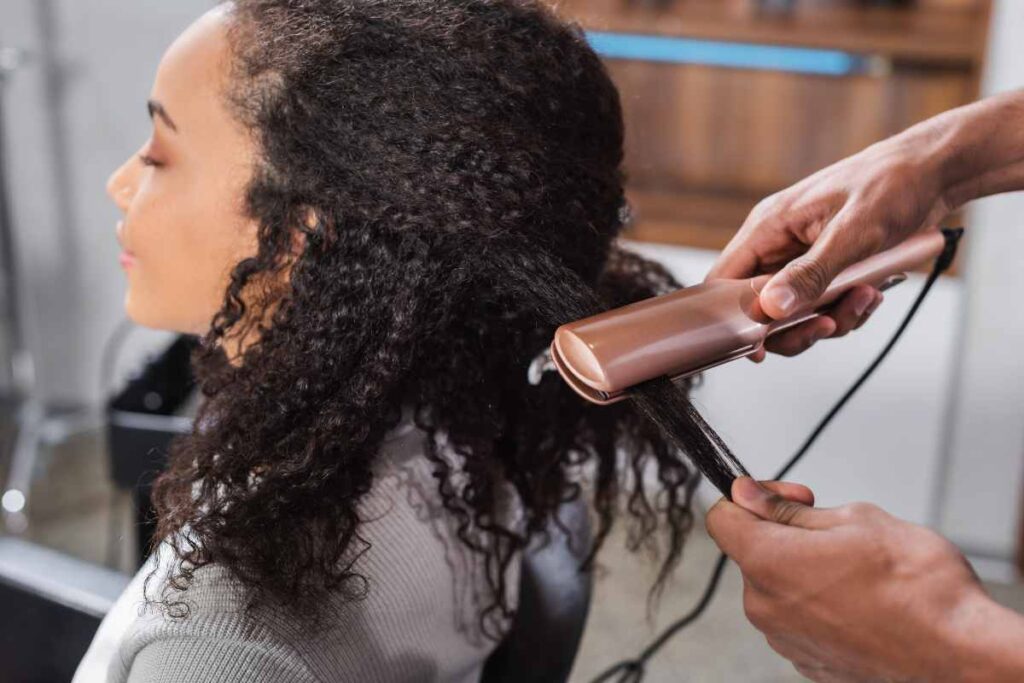
5. Avoid physical stress to hair and manage emotional stress
Certain hair styling methods like hair coloring, heat application with hot irons (curling or flat), and perms/relaxers can damage the hair.
Hairstyles that pull your hair tightly can also cause hair loss, called traction alopecia. While your hair may have better tolerated these hair styling approaches before the menopause journey, if the hair shaft has become more fragile due to the hormonal transition, it can lead to dry, brittle, damaged, and broken hair.
If you swim or spend time in the sun, wear a swim cap and a hat. Both chlorine and strong sun can contribute to hair breakage.
Stress is inevitable, but healthy daily practices can help keep it in check! Because of the link between stress and hair loss, it can be worth paying extra attention to. Check out these stress reduction techniques to incorporate into your daily life.
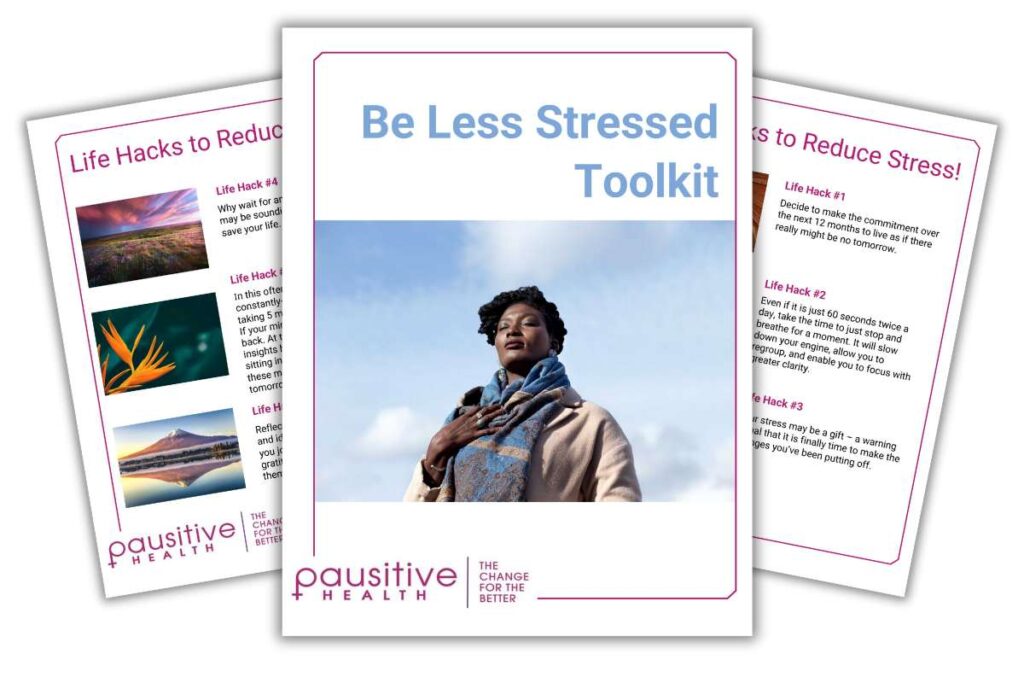
Be Less Stressed
Feeling stressed or overwhelmed? Learn life hacks to reduce stress with the Be Less Stressed toolkit.
"*" indicates required fields
6. Use nourishing treatments
While hair shafts can’t “heal,” nourishing treatments such as hair oils and conditioners can help improve its appearance and make it easier to manage.
7. Diabetes management
If you have diabetes and your blood sugar (glucose) levels routinely run high, you may experience hair loss (especially in Type 1 diabetes).
The hormonal changes that occur during the menopause journey increase the risk of new-onset diabetes and can make diabetes harder to manage if you already have it. Therefore, control of your glucose levels is key, which means being adherent to your medications if they have been prescribed and living a healthy lifestyle.
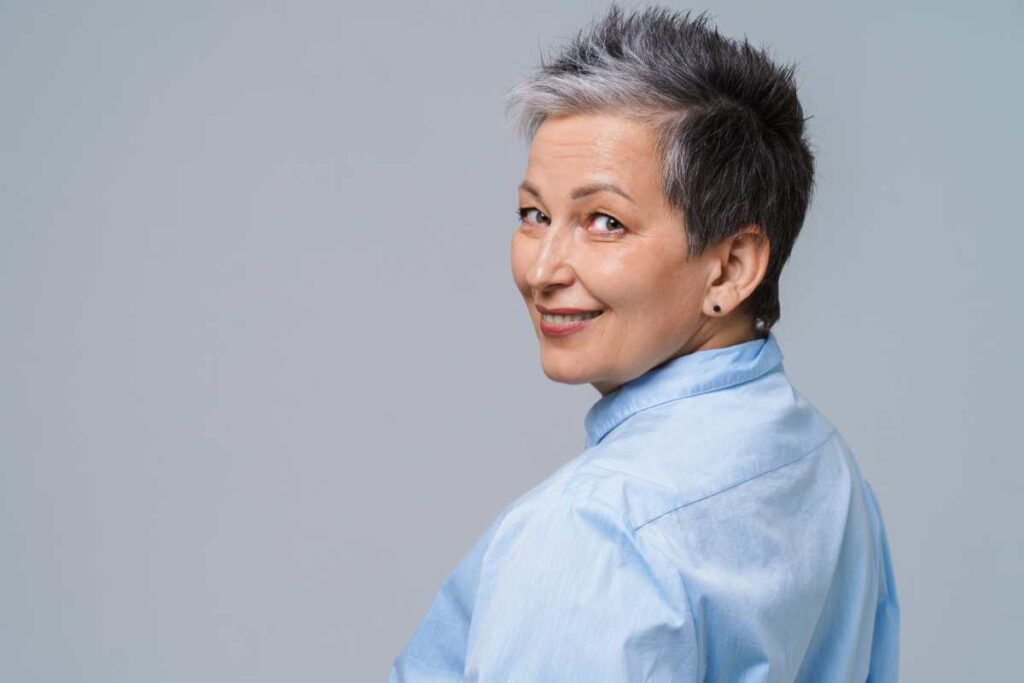
You can make a change for the better!
While menopausal hair loss is a common and natural phenomenon, it can still impact self-esteem and confidence and often is not welcomed with open arms. Just know that you’re not alone. And some women+ may embrace the change fully.
Understanding the underlying causes and exploring ways to manage them, whether through lifestyle changes or medical interventions, can help women+ navigate this shift with greater ease. As always, consult with healthcare professionals to find a plan that’s right for your unique needs.
Goluch-Koniuszy ZS. Nutrition of women with hair loss problem during the period of menopause. Prz Menopauzalny. 2016 Mar;15(1):56-61. doi: 10.5114/pm.2016.58776. Epub 2016 Mar 29. PMID: 27095961; PMCID: PMC4828511.
Chaikittisilpa S, MD, MSc; Rattanasirisin N, MD; Panchaprateep R, MD, PhD; Orprayoon, N MD; Phutrakul P, PhD; Suwan A, MD; Jaisamrarn U, MHS. Prevalence of female pattern hair loss in postmenopausal women: a cross-sectional study. Menopause 29(4):p 415-420, April 2022. | DOI: 10.1097/GME.0000000000001927
Treating Female Pattern Hair Loss | Harvard Health Publishing®
Female Pattern Baldness | Mount Sinai
Zouboulis C C., Blume-Peytavi U, Kosmadaki M, Roó E, Vexiau-Robert D, Kerob D Goldstein S & R. (2022) Skin, hair and beyond: the impact of menopause. Climacteric, 25:5, 434-442, DOI: 10.1080/13697137.2022.2050206
Mirmirani P. Managing Hair Loss in Midlife Women. Maturitas Volume 74, Issue 2, February 2013, p. 119-122. DOI: https://doi.org/10.1016/j.maturitas.2012.10.020
Brough KR, Torgerson RR. Hormonal therapy in female pattern hair loss. Int J Womens Dermatol. 2017 Feb 24;3(1):53-57. doi: 10.1016/j.ijwd.2017.01.001. PMID: 28492055; PMCID: PMC5419033.
Goluch-Koniuszy Z. Nutrition of women with hair loss problem during the period of menopause. Menopause Review/Przegląd Menopauzalny. 2016;15(1):56-61. doi:10.5114/pm.2016.58776.
Kamp E, Ashraf M, Musbahi E, DeGiovanni C. Menopause, skin and common dermatoses. Part 1: hair disorders. Clinical and Experimental Dermatology, Volume 47, Issue 12, 1 December 2022, Pages 2110–2116, https://doi.org/10.1111/ced.15327
Ali I, Wojnarowska F. Physiological changes in scalp, facial and body hair after the menopause: a cross‐sectional population‐based study of subjective changes. British Journal of Dermatology, Volume 164, Issue 3, 1 March 2011, Pages 508–513, https://doi.org/10.1111/j.1365-2133.2010.10156.x
Sebaceous Glands | Cleveland Clinic
InformedHealth.org [Internet]. Cologne, Germany: Institute for Quality and Efficiency in Health Care (IQWiG); 2006.What is the structure of hair and how does it grow? 2019 Aug 29. Available from: https://www.ncbi.nlm.nih.gov/books/NBK546248/
Huges E, Saleh D. Telogen Effluvium. [Updated 2023 May 29]. In: StatPearls [Internet].Treasure Island (FL): StatPearls Publishing; 2024 Jan-. Available from: https://www.ncbi.nlm.nih.gov/books/NBK430848/
Female Pattern Hair Loss (FPHL) | American Hair Loss Association
Stress Management | Mayo Clinic
Choi, S., Zhang, B., Ma, S. et al. Corticosterone inhibits GAS6 to govern hair follicle stem-cell quiescence. Nature 592, 428–432 (2021). https://doi.org/10.1038/s41586-021-03417-2
Grymowicz M, Rudnicka E, Podfigurna A, Napierala P, Smolarczyk R, Smolarczyk K, Meczekalski B. Hormonal Effects on Hair Follicles. International Journal of Molecular Sciences. 2020; 21(15):5342. https://doi.org/10.3390/ijms21155342
Polycystic ovary syndrome | World Health Organization
Polycystic ovary syndrome (PCOS) | Mayo Clinic
Insulin Resistance & Prediabetes | National Institute of Diabetes and Digestive and Kidney Diseases
Does Menopause Affect Polycystic Ovary Syndrome (PCOS)? | Healthline Media
Ahn D, Kim H, Lee B, Hahm DH. Psychological Stress-Induced Pathogenesis of Alopecia Areata: Autoimmune and Apoptotic Pathways. Int J Mol Sci. 2023 Jul 20;24(14):11711. doi: 10.3390/ijms241411711. PMID: 37511468; PMCID: PMC10380371.
Hair Loss Types: Alopecia Areata Causes | American Academy of Dermatology Association
Almohanna HM, Ahmed AA, Tsatalis JP, Tosti A. The Role of Vitamins and Minerals in Hair Loss: A Review. Dermatol Ther (Heidelb). 2019 Mar;9(1):51-70. doi: 10.1007/s13555-018-0278-6. Epub 2018 Dec 13. PMID: 30547302; PMCID: PMC6380979.
Lee H, Jung SJ, Patel AB, Thompson JM, Qureshi A, Cho E. Racial characteristics of alopecia areata in the United States. J Am Acad Dermatol. 2020 Oct;83(4):1064-1070. doi: 10.1016/j.jaad.2019.06.1300. Epub 2019 Jul 3. PMID: 31279016.
How Diet Affects Hair Loss | Healthline Media
Mubki T, Rudnicka L, Olszewska M, Shapiro J. Evaluation and diagnosis of the hair loss patient: part I. History and clinical examination. J Am Acad Dermatol. 2014 Sep;71(3):415.e1-415.e15. doi: 10.1016/j.jaad.2014.04.070. PMID: 25128118.
Spivak JL, Jackson DL. Pellagra: an analysis of 18 patients and a review of the literature. Johns Hopkins Med J. 1977 Jun;140(6):295-309. PMID: 864902.
Mercury exposure and poisoning | Better Health Channel
Peters J B. BA; Warren M. P. MD1. Reversible alopecia associated with high blood mercury levels and early menopause: a report of two cases. Menopause 26(8):p 915-918, August 2019. | DOI: 10.1097/GME.0000000000001332
Alopecia Areata | National Alopecia Areata Foundation
Brough KR, Torgerson RR. Hormonal therapy in female pattern hair loss. Int J Womens Dermatol. 2017 Feb 24;3(1):53-57. doi: 10.1016/j.ijwd.2017.01.001. PMID: 28492055; PMCID: PMC5419033.
Wu J, Zhang P, Cohen M. of Johnson & Johnson Consumer Inc. 5% Minoxidil topical foam on women: Menopause and other covariates. Journal of the American Academy of Dermatology. October 2019. Volume 81, Issue 4, Supplement 1, AB3. DOI:https://doi.org/10.1016/j.jaad.2019.06.053
The 13 Best Foods for Hair Growth | Healthline Media
Collagen | Cleveland Clinic
Collagen Won’t Hurt Hair Growth, But It Probably Won’t Help Either | Cleveland Clinic
Vitamin D | The President and Fellows of Harvard College
What is Anemia? | National Heart, Lung, and Blood Institute
Niacin | National Institutes of Health
Hair loss after weight loss: What is the connection | Healthline Media
Sukanya C, Nattiya R, Ratchathorn P, Nalina O, Phanuphong P, Ammarin S, Unnop J. Prevalence of female pattern hair loss in postmenopausal women: a cross-sectional study. Menopause 29(4):p 415-420, April 2022. | DOI: 10.1097/GME.0000000000001927
Hairstyles That Pull Can Lead to Hair Loss | American Academy of Dermatology Association
Menopause Hair Loss Prevention | Healthline Media
Tips for Healthy Hair | American Academy of Dermatology Association
You may also like…

Menopause and Hair Loss: Understand the Connection and Find the Right Solution
Learn about solutions for menopausal women experiencing thinning hair, a receding hairline, or bald patches.

Foods For Menopause: 9 Best Foods To Help Menopause
Did you know you can manage your menopause symptoms with food? Learn the 10 best foods packed with the necessary nutrients to feel better.
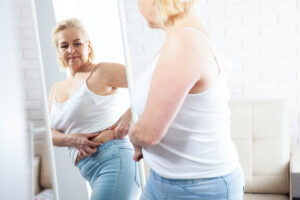
Weight Gain in Menopause Have You Down? Try These 9 Lifestyle Changes
Have you noticed your clothes getting tighter as you age? Weight gain is common in menopause. Learn how to lose weight and feel better.

